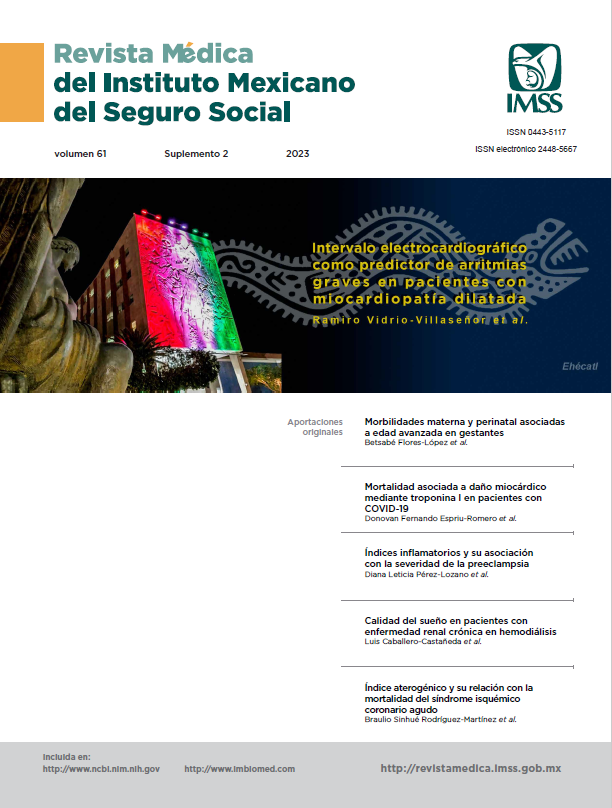Esófago de Barrett: diferencia histoquímica entre células caliciformes y células azules
##plugins.themes.themeEleven.article.main##
Palabras clave
Metaplasia, Reacción del Ácido Peryódico de Schiff, Azul Alciano, Esófago de Barrett, Estudios Transversales
Resumen
Introducción: el esófago de Barrett (EB) es el recambio de la mucosa habitual esofágica por un epitelio cilíndrico simple con presencia de células caliciformes (CC) de tipo intestinal. Se ha relacionado con factores de riesgo como la enfermedad por reflujo gastroesofágico (ERGE), consumo inapropiado de alimentos irritantes, tabaquismo o sobrepeso. Hay células imitadoras de las CC, las células azules (CA), que dificultan el diagnóstico del EB y es debido a falta de una definición precisa sobre la naturaleza y ubicación de la unión gastroesofágica y las variaciones microscópicas en esta zona.
Objetivo: identificar morfológicamente y con las técnicas de histoquímica azul alciano (AA) y ácido peryódico de Schiff (PAS) las CC y las CA.
Material y métodos: estudio transversal retrolectivo analítico; se incluyeron 45 muestras de pacientes diagnosticados con EB.
Resultados: las características morfológicas son similares en ambas variedades celulares. La tinción de PAS fue del 100%, a diferencia de la tinción de AA, con solo 16 casos con tinción, correspondiente al 35.55%.
Conclusiones: la tinción de PAS tiene una alta sensibilidad y especificidad para la identificación de CC, lo cual es fundamental para el correcto diagnóstico de la EB. La presencia de CA detectadas mediante AA no excluye el diagnóstico de EB, ya que ambos tipos celulares pueden coexistir.
Referencias
Sarem M, Martínez F, Salvia M, Corti R. Low-grade dysplasia in Barrett’s esophagus: A problematic diagnosis. Gastroenterol Hepatol. 2022; 45(10): 228-34. doi: 10.1016/j.gastrohep. 2022.10.002.
Valdovinos F, Bernal A, Barreto R, Briseño D, Martínez J, Romano A et al. Barrett’s esophagus: Ten years of experience at a tertiary care hospital center in Mexico. Rev Gastroenterol Mex. 2018;83(1):25-30. doi: 10.1016/j.gastrohep.2022.10.002.
Huerta F, Bielsa M, Remes J, Valdovinos M, Tamayo-de la Cuesta J. Diagnóstico y tratamiento de la enfermedad por reflujo gastroesofágico: recomendaciones de la Asociación Mexicana de Gastroenterología. Rev Gastroenterol Mex. 2016;81(4): 208-22. doi: 10.1016/j.rgmx.2016.04.003.
Moinova H, Laframboise T, Lutterbaugh J, Chandar AK, Dumot J, Faulx A et al. Identifying DNA methylation biomarkers for non-endoscopic detection of Barrett’s esophagus. Sci Transl Med. 2018;10:1-11. doi: 10.1126/scitranslmed.aao5848.
Bellizi A, Odze R. Histopathology of Barrett’s esophagus: A review for the practicing gastroenterologist. Techniques in Gastrointestinal Endoscopy. 2010;2:69-81. doi: 10.1016/j. tgie.2010.02.008.
Srivastava A, Appelman H, Goldsmith JD, Davison JM, Hart J, Krasinskas AM. The Use of Ancillary Stains in the Diagnosis of Barrett Esophagus and Barrett Esophagus-associated Dysplasia: Recommendations From the Rodger C. Haggitt Gastrointestinal Pathology Society. Am J Surg Pathol. 2017;41(5):e8- 21. doi: 10.1097/PAS.0000000000000819.
Zhang L, Sun B, Zhou X, Wei Q, Liang S, Luo G, et al. Barrett’s Esophagus and Intestinal Metaplasia. Frontiers in Oncology. Frontiers Media. 2021;11:1-14. doi: 10.3389/fonc.2021.630837.
Tofani C, Gandhi K, Spataro J, Yoo J, Murphy M, Mohan N, et al. Esophageal adenocarcinoma in a first-degree relative increases risk for esophageal adenocarcinoma in patients with Barrett’s esophagus. United European Gastroenterol J. 2019;7 (2):225-9. doi: 10.1177/2050640618817098.
Elizondo J, Chaverri G, Téllez I. Actualización en Esófago de Barrett. Revista Médica Sinergia. 2019 Dec;4(12):304-14. doi: 10.31434/rms.v4i12.304.
Soto D, Campos I, Vázquez J, Sepulveda A. Riesgo para desarrollar reflujo gastroesofágico severo en neonatos operados de hernia diafragmática congénita. Rev Med Inst Mex Seguro Soc. 2014;52(2):56-61. Disponible en: http://revistamedica. imss.gob.mx/editorial/index.php/revista_medica/article/view/ 775/1321.
Vázquez J, Mercadillo M, Celis J, Navarrete J. Consumo de tabaco en derechohabientes del IMSS. Rev Med Inst Mex Seguro Soc. 2009;47(4):367-76. Disponible en: http://revistamedica. imss.gob.mx/editorial/index.php/revista_medica/article/view/ 1911/2422.
Cruz M, González F, Ayala E, Lidia O, Vargas G, Zarate A et al. Sobrepeso, obesidad, síndrome metabólico e índice cintura/talla en el personal de salud. Rev Med Inst Mex Seguro Soc. 2015;53(1):36-41. Disponible en: http://revistamedica. imss.gob.mx/editorial/index.php/revista_medica/rt/ printerFriendly/52/344.
Signorini F, Viscido G, Bocco M, Obeide L, Moser F. Impact of Gastric Bypass on Erosive Esophagitis and Barret’s Esophagus. Obes Surg. 2020;30(4):1194-9. doi: 10.1007/ s11695-019-04333-1.
Naini B, Souza R, Odze R. Barrett’s esophagus: A comprehensive and contemporary review for pathologists. Am J Surg Pathol. 2016;40(5):e45-66. doi: 10.1097/PAS.0000000000000598.
Yin F, Hernandez D, Lai J, Liu X. Histopathology of Barrett’s Esophagus and Early-Stage Esophageal Adenocarcinoma: An Updated Review. Gastrointestinal Disorders. 2018;1(1):147- 63. doi: 10.3390/gidisord1010011.
Montgomery EA, Canto MI, Srivastava A. Evaluation and reporting of biopsies from the columnar-lined esophagus and gastro-esophageal junction. Ann Diagn Pathol. 2019;39:111-7. doi: 10.1016/j.anndiagpath.2019.02.012.
Tan W, di Pietro M, Fitzgerald R. Past, present and future of Barrett’s oesophagus. European Journal of Surgical Oncology (EJSO). 2017;43(7):1148-60. doi: 10.1016/j.ejso.2017.02.004.
Odze R. Histology of Barrett’s Metaplasia: Do Goblet Cells Matter?, Digestive Diseases and Sciences. Dig Dis Sci. 2018; 63(8):2042-51. doi: 10.1007/s10620-018-5151-z.
Montgomery E, Arnold C, Lam-Himlin D, Salimian K, Waters K. Some observations on Barrett esophagus and associated dysplasia. Annals of Diagnostic Pathology. 2018;39:5-82. doi: 10.1016/j.anndiagpath.2018.09.013.
Lopes C, Pereira J, Hartmann A, Lopes C. Expression of Mucin-2 and correlation with PAS-alcian blue stain in Barrett’s esophagus. Hepatogastroenterology. 2006;53(70):511-5. doi: 10.1111/j.1365-2559.2004.01849.x.
Torrado J, Piazuelo B, Ruiz I, Izarzugaza M, Constanza Camargo M, Delgado A, et al. El fenotipo de las mucinas en el esófago de Barrett: Mucin phenotypes in Barrett’s esophagus. Revista Española de Patología. 2010;43(1):8-15. doi: 10.1016/j.patol.2010.02.001.
Won-Tak C, Lauwer G, Montgomery E. Utility of ancillary studies in the diagnosis and risk assessment of Barrett’s esophagus and dysplasia. Modern Pathology. 2022;35:1000-12. doi: 10.1038/s41379-022-01056-0.
Kong J, Crissey M, Funakoshi S, Kreindler J, Lynch J. Ectopic Cdx2 expression in murine esophagus models an intermediate stage in the emergence of Barrett’s esophagus. PLoS One. 2011;6(4): 1-12. doi: 10.1371/journal.pone.0018280.
Johnson D, Abdelbaqui M, Tahmasbi M, Mayer Z, Lee H, Malafa MP et al. CDX2 protein expression compared to alcian blue staining in the evaluation of esophageal intestinal metaplasia. World J Gastroenterol. 2015;21(9):2770-6. doi: 10.3748/wjg. v21.i9.2770.
Shaheen N, Falk G, Iyer P, Gerson L. ACG Clinical Guideline: Diagnosis and Management of Barrett’s Esophagus. American Journal of Gastroenterology. 2016;111(1):30-50. doi: 10.1038/ ajg.2015.322.
Tamayo J. Esófago de Barrett (Actualidades en el diagnóstico y tratamiento). Rev Gastroenterol Mex. 2013;67(1):42-8. doi: 10.1016/j.rgmx.2013.06.020.


